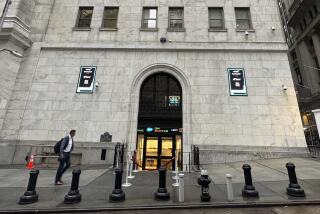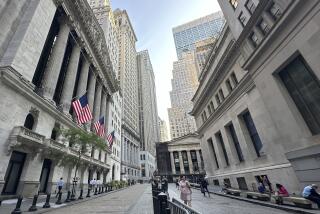Gold Soars to 4-Year High as Stocks and Dollar Falter
SACRMANTO — Gold, a favorite investor haven during financial unrest, may finally be mounting a comeback after languishing during years of low inflation and soaring stock and bond markets.
Buoyed by the weak dollar, falling stock prices and fears of renewed inflation and higher interest rates, the price of gold rose Tuesday to its highest level in more than four years. Gold rose more than $14 for the day to reach $451 an ounce in late New York trading--the highest price since Feb. 24, 1983, when gold went for $469.90 an ounce.
The rise stirred hopes among gold advocates that the metal may begin to regain some of the luster it had in the late 1970s.
“There’s clearly a major shift in interest in gold,” said Ian C. MacDonald, a precious metals investment adviser at the New York branch of Credit Suisse, a major Swiss bank that trades precious metals. “If U.S. investors get into it in a big way, I don’t know how high it could go.”
Gold derived much of its strength Tuesday from sell-offs in the U.S. stock and bond markets. The widely watched Dow Jones average of 30 industrial stocks fell 34.09 points to close at 2,252.98 Tuesday, following a 51.71-point drop Monday and a 51-plus point decline all of last week. Trading volume on the New York Stock Exchange Tuesday was the second highest ever.
Investors selling stocks are undoubtedly placing at least some of the proceeds in gold, which tends to move in the opposite direction from stocks and bonds, analysts said.
Also, gold capitalized on a continued plunge in the dollar and fears that it will spark renewed inflation. The dollar fell in part because of news that the nation’s trade deficit widened to $15.1 billion in February, the third highest monthly trade deficit ever.
The dollar suffered also from comments Tuesday by Federal Reserve Board Governor Robert Heller, who was quoted as saying he saw no reason yet for the agency to increase U.S. interest rates to try to boost the dollar.
Dollar Loses Ground
As a result, the dollar closed Tuesday at 140.75 Japanese yen, sharply lower than the 142.20-yen level at the close of trading Monday. That occurred despite reports that the central banks of France, Switzerland, Japan and West Germany were buying dollars on foreign exchange markets in attempts to support the battered currency.
The recent sparkle in gold, valued as a safe haven against financial crisis as well as an inflation hedge, reflects the fact that “the financial system is readying itself for a greater comeback in inflation than was anticipated five or six months ago,” said Peter C. Cavelti, president of Cavelti Capital Management Ltd., a Toronto-based firm that manages gold investments for institutions. “There now is a lot more uncertainty and financial instability than anybody thought.”
Silver Up Sharply
Silver and platinum, which tend to rise and fall with gold, also have risen sharply in recent weeks. Silver, in fact, has outperformed gold lately, rising about $1 an ounce, or more than 15%, in less than a month. On New York’s Commodity Exchange, silver jumped 41.2 cents an ounce to close at $7.26 Tuesday.
Gold had lost its glitter during much of the 1980s. Sparked by double-digit inflation and Middle East tensions, the metal’s price ran up sharply in the late 1970s and hit a record high of $875 an ounce in January, 1980.
But, within a year, the speculative bubble had burst and gold plummeted to below $400. During 1985--when stock prices sizzled amid low inflation and declining interest rates--gold toppled to as low as $285 an ounce.
The metal attained a mini-comeback last year, with prices rising to as high as $440 last September amid concerns about reductions in gold supplies from strife-torn South Africa and massive buying by Japan to provide gold for its popular new Emperor Hirohito bullion coin. But, by year-end, the price had fallen back to around $390, and prices continued to languish for much of this year’s first quarter, amid a lessening of worries about a supply cutoff from South Africa.
Mining Stocks Gain
Although the price of gold has risen nearly 8% in the first quarter, stocks of companies involved in mining gold turned in an even more spectacular performance. Mutual funds that invest in gold-mining stocks rose nearly 50% during the first quarter, according to the New York research firm of Lipper Analytical Securities. Investors often buy gold-mining stocks in anticipation of rises in gold prices and to protect themselves against declines in other stocks.
Whether the price of gold can continue to rise and approach the levels of the late 1970s depends in part on how much gold individual investors in the United States will buy.
Most of the latest price rise has been fueled by buying by European institutional investors such as banks, professional dealers and pension funds, as well as wealthy overseas investors, analysts said. Less-affluent individual investors, who tend to be the last to buy in any speculative binge, are not yet a major force in the market.
No Rush for Gold Coins
The average American investor “is still skeptical about gold. Many were burned in the last gold market cycle,” investment adviser Cavelti said. “Unless they see real evidence that the price is going up and staying up, they will not be in the game.” So far, market experts said, there has been no rush by individuals to snap up gold coins.
Further rises depend in part on whether the dollar falls further and economic tensions mount, analysts said.
If the dollar continues to plummet, a price of $500 or higher is likely before year-end, Cavelti predicted. But other analysts were not so optimistic.
“The dollar can’t fall much further,” said George Parola, a vice president at Deak International, a New York-based foreign exchange and bullion dealer. If the dollar recovers, “you will see profit-taking in precious metals,” he said.
More to Read
Inside the business of entertainment
The Wide Shot brings you news, analysis and insights on everything from streaming wars to production — and what it all means for the future.
You may occasionally receive promotional content from the Los Angeles Times.










